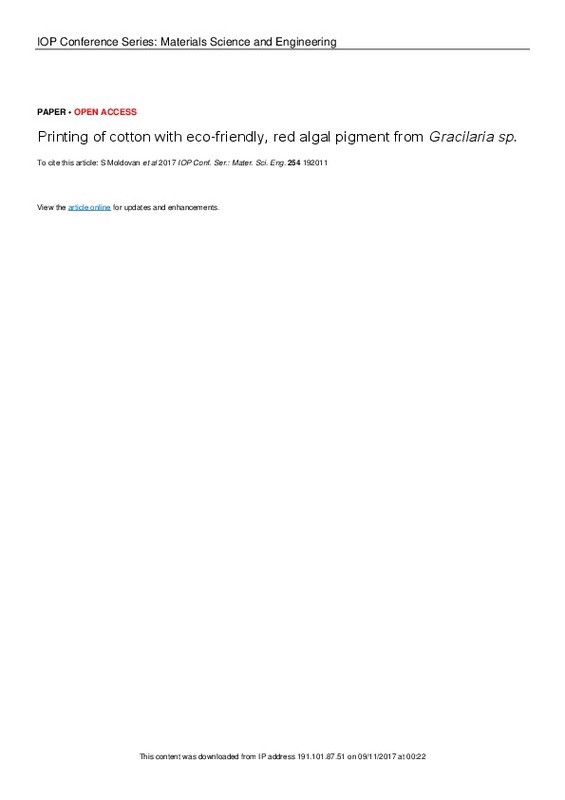JavaScript is disabled for your browser. Some features of this site may not work without it.
Buscar en RiuNet
Listar
Mi cuenta
Estadísticas
Ayuda RiuNet
Admin. UPV
Printing of cotton with eco-friendly, red algal pigment from Gracilaria sp
Mostrar el registro sencillo del ítem
Ficheros en el ítem
| dc.contributor.author | Moldovan, Simona
|
es_ES |
| dc.contributor.author | Ferrándiz, Marcela
|
es_ES |
| dc.contributor.author | Franco, E.
|
es_ES |
| dc.contributor.author | Mira, E.
|
es_ES |
| dc.contributor.author | Capablanca, L.
|
es_ES |
| dc.contributor.author | Bonet-Aracil, M.
|
es_ES |
| dc.date.accessioned | 2018-06-03T04:21:51Z | |
| dc.date.available | 2018-06-03T04:21:51Z | |
| dc.date.issued | 2017 | es_ES |
| dc.identifier.issn | 1757-8981 | es_ES |
| dc.identifier.uri | http://hdl.handle.net/10251/103251 | |
| dc.description.abstract | [EN] Natural dyes represent an emerging trend in the textile industry and eco-fashion due to the increasing awareness of the sustainability concept, which must be applied to the surrounding environment. In the light of the stated problem, the search for alternative sources of dyes, revealed the new, eco-friendly, biodegradable, non-carcinogenic and sustainable colorant matter, the algal biomass. In the present work, the suitability and viability of printing cotton fabrics with pigments obtained from the red macroalgae Gracilaria sp., has been investigated. For this aim, phycoerythrin, the red pigment, was extracted from fresh algal biomass, and used in a laboratory pigment-printing process, employing a natural and synthetic printing paste, for process efficiency comparison. The color values and the rubbing and laundering fastness of the printed substrates were evaluated. Results show that a light pink color can be obtained when applying both tested printing processes, and in terms of color fastness, both printing pastes show good behavior. In conclusion, the algal pigments show a high printing capacity on cotton substrates, either when employing the synthetic conventional paste and; moreover, when applying the more sustainable and eco-friendly natural paste. | es_ES |
| dc.description.sponsorship | This work was supported by the European research project ¨SEACOLORS¨ (Demonstration of new natural dyes from algae as substitution of synthetic dyes actually used by textile industries) within the LIFE 2013 ¨Environment Policy and Governance project application¨ program. | |
| dc.language | Inglés | es_ES |
| dc.publisher | IOP Publishing | es_ES |
| dc.relation.ispartof | IOP Conference Series Materials Science and Engineering | es_ES |
| dc.rights | Reserva de todos los derechos | es_ES |
| dc.subject.classification | INGENIERIA TEXTIL Y PAPELERA | es_ES |
| dc.title | Printing of cotton with eco-friendly, red algal pigment from Gracilaria sp | es_ES |
| dc.type | Artículo | es_ES |
| dc.type | Comunicación en congreso | es_ES |
| dc.identifier.doi | 10.1088/1757-899X/254/19/192011 | es_ES |
| dc.relation.projectID | info:eu-repo/grantAgreement/EC//LIFE13 ENV%2FES%2F000445/EU/Demonstration of new natural dyes from algae as substitution of synthetic dyes actually used by textile industries/LIFE SEACOLORS/ | es_ES |
| dc.rights.accessRights | Abierto | es_ES |
| dc.contributor.affiliation | Universitat Politècnica de València. Departamento de Ingeniería Textil y Papelera - Departament d'Enginyeria Tèxtil i Paperera | es_ES |
| dc.description.bibliographicCitation | Moldovan, S.; Ferrándiz, M.; Franco, E.; Mira, E.; Capablanca, L.; Bonet-Aracil, M. (2017). Printing of cotton with eco-friendly, red algal pigment from Gracilaria sp. IOP Conference Series Materials Science and Engineering. 254:1-6. doi:10.1088/1757-899X/254/19/192011 | es_ES |
| dc.description.accrualMethod | S | es_ES |
| dc.relation.conferencename | 17th AUTEX World Textile Conference | es_ES |
| dc.relation.conferencedate | May 29-31,2017 | es_ES |
| dc.relation.conferenceplace | Corfu, Greece | es_ES |
| dc.relation.publisherversion | https://doi.org/10.1088/1757-899X/254/19/192011 | es_ES |
| dc.description.upvformatpinicio | 1 | es_ES |
| dc.description.upvformatpfin | 6 | es_ES |
| dc.type.version | info:eu-repo/semantics/publishedVersion | es_ES |
| dc.description.volume | 254 | es_ES |
| dc.relation.pasarela | S\348539 | es_ES |
| dc.contributor.funder | European Commission | es_ES |








